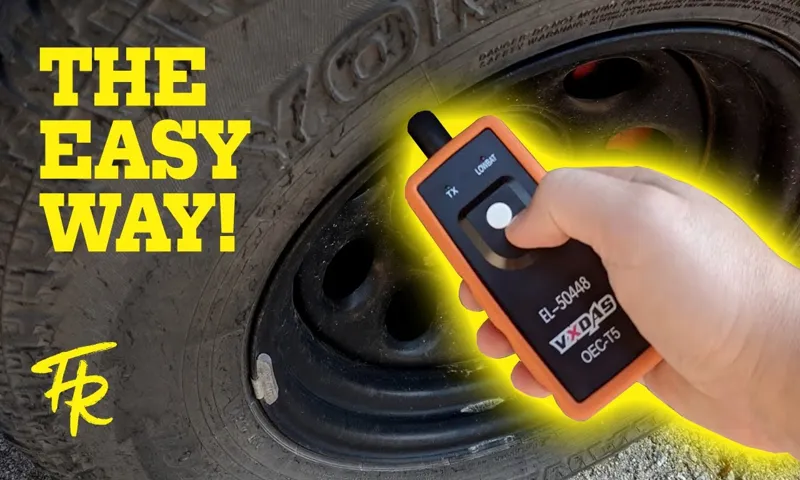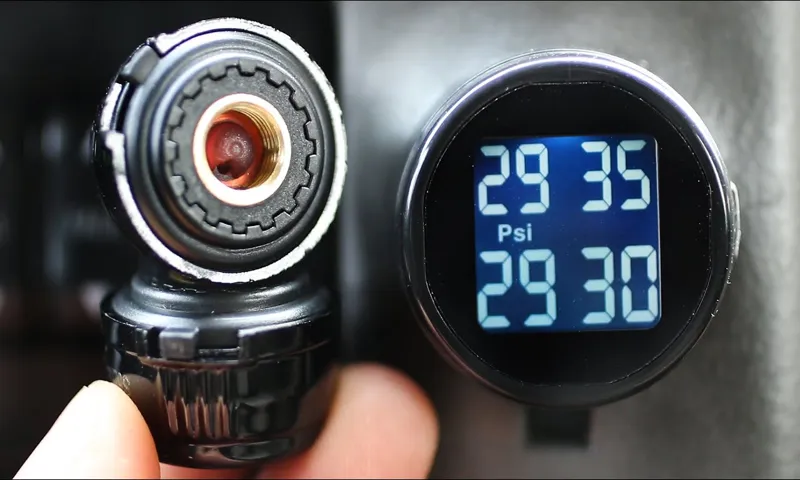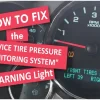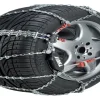Do you know what your tire pressure sensor is telling you? As a crucial component of your vehicle’s safety system, your tire pressure sensor helps you avoid potential accidents by alerting you to low tire pressure. However, it’s not uncommon for drivers to overlook this warning and ignore their tire pressure until it’s too late. That’s why it’s crucial to understand how to program your tire pressure sensor so that you can accurately monitor your tires and stay safe on the road.
Programming your tire pressure sensor might sound intimidating, but it’s a fairly simple process that you can do yourself. In this blog post, we’ll walk you through the steps to program your tire pressure sensor, including how to locate it and how to use the proper tools to set the correct pressure levels. We’ll also discuss some of the benefits of monitoring your tire pressure, such as increased fuel efficiency and longer tire lifespan.
By taking the time to program your tire pressure sensor, you can rest assured that you’re driving on tires that are not only safe but also performing at their best. So, whether you’re a seasoned driver or a new one, take some time to learn about this essential vehicle component and keep yourself and your passengers protected on the road.
Table of Contents
Understanding Tire Pressure Sensors
Knowing how to program your tire pressure sensors is important to keep your vehicle running smoothly and efficiently. These sensors are responsible for monitoring tire pressure and alerting you if any of your tires are underinflated, helping you avoid potential hazards on the road. To program your tire pressure sensors, you will need to consult the owner’s manual for your vehicle and follow the specific instructions provided.
In some cases, you may need a specialized tool to access the sensor programming menu. Once you are in the programming menu, you can enter the necessary data for each tire, such as the recommended pressure level. Keep in mind that the process may differ depending on the make and model of your car, so it’s important to read the instructions carefully and follow them closely.
By knowing how to program your tire pressure sensors, you will be able to ensure your safety while driving and prolong the lifespan of your vehicle’s tires.
Types of Sensors
Tire pressure sensors are integral components of modern automobiles and play an essential role in ensuring your safety. These sensors are critical in determining tire pressure, which, if left unchecked, can cause tire wear and tear, blowouts, and other driving issues. There are primarily two types of tire pressure sensors: Direct TPMS and Indirect TPMS.
Direct TPMS measures the air pressure inside the tire and transmits data to the car’s electronic control unit, and Indirect TPMS relies on other vehicle sensors to calculate tire pressure indirectly. Understanding the type of TPMS in your vehicle is critical in monitoring tire pressure and ensuring optimal performance. Consequently, it is recommended to consult your owner’s manual or a professional mechanic to determine the type of TPMS in your vehicle and take the appropriate actions if necessary.
Remember, proper tire pressure is essential in achieving maximum performance, better economy, and a safe journey.

Why Do You Need Them?
Tire pressure sensors are an indispensable component of modern automobiles that aid in monitoring the air pressure in the tires. These sensors ensure that the tires are inflated to the right level, which is significant for maintaining the vehicle’s overall safety and performance. The sensors alert the driver when the pressure in the tires falls below the recommended level, ultimately preventing accidents.
Moreover, correct tire pressure increases the fuel efficiency of the vehicle, saving money and reducing the carbon footprint of the vehicle. In a nutshell, tire pressure sensors help the driver maintain the optimal performance of the vehicle while ensuring maximum safety levels. It is recommended to check the tire pressure regularly, even if the vehicle has a sensor, to avoid sudden tire failures or blowouts.
Components of a Tire Pressure Monitoring System (TPMS)
Tire Pressure Sensors Tire Pressure Monitoring Systems (TPMS) are an essential component of modern-day vehicles. They are designed to warn drivers of any changes in the air pressure levels of their tires. Understanding how the sensors work is vital in keeping your vehicle safe.
Each wheel is fitted with a sensor that monitors the pressure levels and sends data to the car’s computer system. The sensors work by sending a continuous stream of radio signals to antennas attached to the car. These signals contain information about the tire’s air pressure levels, and if any changes fall outside the recommended levels, an alert is sent to the driver.
Tire pressure sensors come in two types: Direct Sensors and Indirect Sensors. Direct Sensors are mounted onto the valve stems, while Indirect Sensors use the car’s Anti-lock Braking System (ABS) to gauge tire pressure levels. Understanding the different types of pressure sensors and how they work is crucial to maintaining safe driving conditions.
Keep your vehicle running smoothly today by monitoring your tire pressure levels regularly.
Programming Your Tire Pressure Sensor
If you’re wondering how to program your tire pressure sensor, don’t worry, it’s not as complicated as it may seem. First, ensure that you have the proper tools, including a TPMS tool, the vehicle’s owner manual, and the appropriate sensor for your car. Then, follow the instructions provided in your manual for programming the sensor.
Typically, you’ll need to put your vehicle into a programming mode, which may entail holding down a button or using a sequence of actions, depending on your specific car make and model. Once the car is in programming mode, use the TPMS tool to connect to the tire valves and program each sensor as needed, following any additional instructions from your car’s manual. With a bit of patience and know-how, programming your tire pressure sensor can be a breeze, ensuring your car’s safety and optimal performance on the road.
Step 1: Purchase a Programmer Tool
If you want to program your tire pressure sensor, the first thing you need to do is purchase a programmer tool. This tool will allow you to communicate with your sensor and make any necessary changes to its settings. While there are a variety of programmer tools available on the market, it’s important to choose one that is compatible with the specific make and model of your vehicle.
Once you have your programmer tool, it’s a simple matter of connecting it to your sensor and following the instructions provided by the tool. With a little bit of patience, you can have your tire pressure sensor programmed in no time. Whether you want to adjust the pressure thresholds or simply reset the sensor after a tire change, having a programmer tool on hand can make the process much easier.
So don’t hesitate to make the investment in this valuable tool if you want to take control of your tire pressure sensor.
Step 2: Gather All Needed Information
When it comes to programming your tire pressure sensor, the second step is to gather all the necessary information. This includes the make and model of your vehicle, as well as the specific type of sensor you have. It’s also important to know the correct pressure levels for your tires and any other relevant specifications for your vehicle.
This information can usually be found in your owner’s manual or by contacting your dealership or mechanic. Additionally, you may need to download certain software or programming tools to properly program your sensor. By taking the time to gather all the necessary information, you can ensure that your tire pressure sensor is programmed correctly and functioning properly to keep you safe on the road.
Step 3: Turn the Ignition On
To program your tire pressure sensor, you need to turn the ignition on. Once you have properly set up the tool and made sure that it is compatible with your vehicle’s make and model, you can proceed with the programming process. Turning the ignition on allows you to establish a connection between the sensor and the vehicle’s computer, which is essential for the programming to be successful.
While some sensors may be programmed by simply driving the vehicle, most require a tool to be physically connected to the vehicle. This tool will communicate with the sensor and the computer to program the sensor with the correct pressure readings. Once you have turned the ignition on, follow the instructions on the tool to complete the programming process.
By following these steps, you can ensure that your tire pressure sensors are accurately calibrated and ready to keep you safe on the road.
Step 4: Press the Reset Button on the Tool
Once you’ve ensured that your tire pressure sensor programming tool is correctly connected to your vehicle’s OBD-II port, it’s time to move on to the next step. Press the reset button on your tool to initiate the programming process. This will send a signal to your vehicle’s computer to communicate with your tire pressure sensors.
Keep an eye on both your tool and your vehicle’s dashboard during this process, as you may need to respond to prompts or indications on either device. Once the programming process is complete, you should see an indication on your tool that the sensors have been successfully programmed. Congratulations! You’ve taken another step towards ensuring the safety and efficiency of your vehicle.
Step 5: Follow the Tool’s Instructions for Your Specific Vehicle Model
Programming the tire pressure sensor is the final step in ensuring your vehicle’s safety system is functioning properly. It’s important to follow the tool’s instructions for your specific vehicle model, as each make and model may require different steps. This process involves linking the tire pressure monitoring system’s receiver to the sensors themselves, allowing for accurate readings and warnings if the tire pressure drops too low.
The programming instructions may vary, but they typically involve starting the vehicle and turning the key to the “on” position, pressing the programming button, and allowing the tool to communicate with the sensors. Once the process is complete, your tire pressure monitoring system will be calibrated and ready to provide accurate readings. It’s important to keep in mind that newer vehicles often require professional programming by a mechanic, so be sure to check the vehicle’s manual for guidance.
By programming your tire pressure sensor, you can have peace of mind knowing that your vehicle’s safety system is functioning optimally.
Tips for Maintaining Your TPMS
If you want to ensure that your vehicle’s tire pressure monitoring system (TPMS) stays in top condition, you should know how to program tire pressure sensors. First and foremost, it’s important to consult your vehicle manual to understand the correct tire pressure requirements for your car. Once you have that information, you can use a TPMS tool to program your tire pressure sensors accurately.
Additionally, be sure to check on your sensor batteries regularly and replace them as needed to maintain proper functionality. Finally, avoid rough driving, which can cause damage to the sensors, and ensure that your tires are properly inflated to avoid false readings and keep your TPMS functioning optimally. By following these simple tips, you can maintain your TPMS’ longevity and ensure that your vehicle stays in top condition.
Check Your Tire Pressure Regularly
Maintaining your TPMS is essential if you want to ensure that your tire pressure is at the recommended level at all times. While TPMS technology has made it easier for drivers to monitor their tire pressure, it is important to keep in mind that the system still requires regular maintenance. One of the most important tips for maintaining your TPMS is to check your tire pressure regularly.
This will not only help to keep your vehicle running smoothly but it will also improve your mileage and save you money on fuel. Moreover, it will help to extend the life of your tires and prevent potential blowouts. Regular tire pressure checks are especially important during cold winter months when tire pressure tends to drop due to temperature changes.
By following these simple tips for maintaining your TPMS, you can ensure that you’re always driving safely and smoothly on the road.
Replace Missing or Broken Sensors Immediately
TPMS maintenance One of the most important things you can do to keep your TPMS functioning properly is to replace missing or broken sensors as soon as possible. A missing sensor can significantly reduce the effectiveness of your system and make it difficult to get an accurate reading on your tire pressure. Additionally, a broken sensor can cause false alarms or even completely fail, leaving you without any warning if your tire pressure drops dangerously low.
To ensure your TPMS stays in top condition, make sure to check your sensors regularly and replace any that are missing or not working correctly. By taking care of your TPMS sensors, you can enjoy more efficient vehicle performance and ensure greater safety on the road.
Stay Informed About Changes in Your TPMS
Maintaining a healthy TPMS is essential for the safety and performance of your vehicle. Here are a few tips that can help you stay informed about changes in your TPMS. Firstly, make sure to inspect your TPMS sensors regularly for any signs of wear and tear.
These sensors are exposed to harsh conditions on the road, and a damaged sensor can lead to an inaccurate reading or malfunction. Secondly, keep an eye out for warning lights on your dashboard. If you notice the TPMS warning light illuminating, it’s a sign that something is wrong with your system.
Lastly, consult your owner’s manual to understand the specific maintenance requirements for your TPMS. Each vehicle and system is unique, and staying up-to-date with the recommended maintenance intervals will prevent any future problems. By following these simple tips, you can ensure that your TPMS is functioning correctly and providing you with accurate data about your tire pressure.
Conclusion
In conclusion, programming a tire pressure sensor may seem like a daunting task, but with the right tools and a little bit of know-how, it can be a breeze. By following the manufacturer’s instructions and utilizing a tire pressure monitoring system tool, you’ll be able to calibrate your sensors and ensure optimal tire performance. So, whether you’re a seasoned mechanic or a tech-savvy novice, programming your tire pressure sensors can be an easy and rewarding process.
Just remember to stay focused, trust the process, and let the digital magic do its thing!”
FAQs
What is a tire pressure sensor?
A tire pressure sensor is a device that monitors the air pressure inside a tire and sends information to the vehicle’s computer system.
How does a tire pressure sensor work?
Tire pressure sensors use radio frequency technology to send data from the tire to the vehicle’s onboard computer. The sensor measures the air pressure and temperature inside the tire and transmits this information to the computer.
Why is it important to have a working tire pressure sensor?
Maintaining proper tire pressure is important for safety and fuel efficiency. A malfunctioning tire pressure sensor can cause inaccurate readings, leading to underinflated or overinflated tires that can affect handling and increase the risk of a blowout.
How often should I check my tire pressure sensor?
It is recommended to check your tire pressure at least once a month, or before any long road trips. If you receive a tire pressure warning on your dashboard, it is important to have it checked immediately.
Can I replace a tire pressure sensor myself?
It is possible to replace a tire pressure sensor yourself, but it may require special tools and knowledge of your vehicle’s system. It is recommended to have a professional mechanic replace the sensor for you.
What is the cost to replace a tire pressure sensor?
The cost to replace a tire pressure sensor can vary depending on the make and model of your vehicle, as well as the location of the sensor. On average, it can cost anywhere from $50 to $250 per sensor.
How long do tire pressure sensors last?
Tire pressure sensors can last anywhere from 5 to 10 years, depending on the quality and usage. It is important to have them checked regularly to ensure they are functioning properly.



